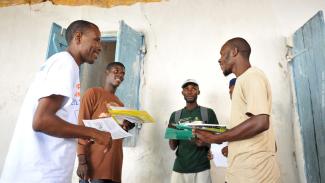Key stakeholders and program participants could help drive the development, implementation, and success of any energy efficiency policy or program.
Activities to set goals and plan programming should include key stakeholders from the sector that is being targeted.
For example, if USAID mission staff are setting energy savings goals for the residential building sector, they could engage international financing institutions (IFIs; see more below), utilities, nongovernmental organizations, local retailers, and installation contractors, and others as needed. This type of collaborative goal-setting will increase buy-in from key stakeholders, help ensure that the targets are realistic, and create a road map for success with which all parties will be comfortable.
Key stakeholders and their traditional roles in energy efficiency programs are described below. This list is illustrative, including many of the stakeholders that typically administer and participate in energy efficiency programs.
Governments
Governments often lead the charge in addressing energy efficiency. They do so by adopting policies that set high-level goals for energy savings and reduced emissions of greenhouse gases, or that state specific standards for buildings and technologies.
Regulations and codes: Codes for buildings, as well as testing and labeling standards for products and equipment, are effective tools for advancing efficiency in the market. Governments can also reform power sector regulatory policies as needed to enable utilities to run customer-based energy efficiency programs.
Financial signals: Financial incentives, including tax credits and value-added tax (VAT) exemptions for energy-efficient products, are additional tools used by governments to promote efficiency in the marketplace.
Partners: Government partners may include energy ministries, units that oversee private investment, and regulators.
Regulators, in particular, often play an important role in promoting energy efficiency. On the financing side, some regulators have the authority to set rates that are structured to compensate utilities for the capital expenditures they incur in implementing energy efficiency programs. Furthermore, regulators can adopt various rate designs and structures—such as time-of-use rates—to promote energy efficiency among consumers. These types of programs incentivize certain changes in behavior or further the adoption of energy efficiency measures at the household level.
Consumers
For an energy efficiency program to take hold, consumers--whether individuals, businesses, or local governments--need to understand the benefits of efficiency, buy into the program goals, and give input on design features. This group of stakeholders best understands the barriers, whether informational or technical, that stand between them and energy efficiency choices.
Financial Institutions
International financing institutions often share USAID’s goal of promoting energy efficiency and reducing greenhouse gas emissions. Furthermore, they have the ability to finance projects and programs in ways that complement how USAID creates policy frameworks, program designs, and/or project preparation plans.
Traditional financial institutions are also mobilizing to unlock funding for energy efficiency projects. The United Nations Environment Programme Finance Initiative (UNEP FI) represents one such initiative, and the World Bank and United Nations joint SEforALL Energy Efficiency Finance Accelerator is another.
Another source of financing is energy service companies (ESCOs). ESCOs, which may be either commercial or nonprofit, are a growing industry across developing economies. They offer expertise in estimating and implementing energy cost savings measures. ESCOs also can provide up-front financing for energy efficiency projects, with beneficiaries using their savings to repay over time.
Utilities
Electric, gas, district heat, and water utilities all can play a major role in administering and implementing energy efficiency programs.
Energy efficiency programs reduce peak energy demand, which can benefit utilities that have insufficient generation capacity. Moreover, if political or social pressure prevents utilities from assessing tariffs that are sufficient to recover costs, promoting energy efficiency can reduce financial losses. Energy efficiency can also help utilities reduce involuntary load shedding (i.e., brownouts or rolling blackouts), improve grid reliability, and avoid costly capital expenditures on new power plants.
Contractors
Contractors are the skilled laborers and technical professionals needed to install energy-efficient products, follow efficient building practices, and integrate energy efficiency into existing processes and systems. For voluntary market-based programs, contractors must also be able to effectively sell and communicate the benefits of energy efficiency to consumers, in order to convince them to participate in programs.
Manufacturers and Retailers
Manufacturers and retailers directly influence the availability of energy-efficient products in the market. At the same time, both regulatory policy and voluntary programs can influence manufacturers and retailers to make decisions that improve the energy efficiency of the products they make or sell.
While not all developing countries will have a robust manufacturing or retail sector, the ability to provide energy-efficient products and equipment to energy users is crucial for program success.
Non-Governmental Organizations (NGOs)
NGOs with close ties to communities can both educate consumers about energy efficiency and recruit local participants. NGOs also can solicit support for efficiency initiatives among policy makers. However, when lobbying or advocacy is involved, potential conflicts of interest can be avoided by ensuring that the goals of an energy efficiency program align to some degree with the NGO’s mission.

Kendra Helmer / USAID
